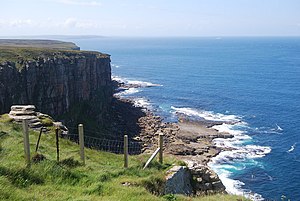Dunnet Head: Difference between revisions
Created page with "right|thumb|300px|Cliffs at Dunnet Head {{county|Caithness}} '''Dunnet Head''' is a headland in Caithness, whos..." |
No edit summary |
||
| Line 1: | Line 1: | ||
[[File:Dunnet Head cliffs - geograph.org.uk - 1387084.jpg|right|thumb|300px|Cliffs at Dunnet Head]] | [[File:Dunnet Head cliffs - geograph.org.uk - 1387084.jpg|right|thumb|300px|Cliffs at Dunnet Head]] | ||
{{county|Caithness}} | {{county|Caithness}} | ||
'''Dunnet Head''' is a headland in [[Caithness]], whose tip is the [[Extreme points of the United Kingdom|most northerly point]] of the mainland of [[Great Britain]]. The point, known as '''Easter Head''', is at {{ | '''Dunnet Head''' is a headland in [[Caithness]], whose tip is the [[Extreme points of the United Kingdom|most northerly point]] of the mainland of [[Great Britain]]. The point, known as '''Easter Head''', is at {{wmap|58.6725|-3.37528|zoom=14}}, or grid reference {{map|ND202767}}. | ||
The traditional measure of Great Britain is '[[Land's End to John o' Groats]]', and while John o' Groats is further into the extreme corner of the land, which extremity is [[Duncansby Head]], Dunnet Head surpasses both for latitude, marking the northernmost point. | The traditional measure of Great Britain is '[[Land's End to John o' Groats]]', and while John o' Groats is further into the extreme corner of the land, which extremity is [[Duncansby Head]], Dunnet Head surpasses both for latitude, marking the northernmost point. | ||
| Line 13: | Line 13: | ||
Near the Dunnet Head lighthouse are minor fortifications built during Second World War to protect the naval base at [[Scapa Flow]], including a Chain Home Low radar station and a bunker used by the Royal Observer Corps during the Cold War. Burifa Hill on Dunnet Head was the site of the master station and a monitoring station of the northern GEE chain of radio navigation stations during Second World War. There was also an artillery range on Dunnet Head during WWII. | Near the Dunnet Head lighthouse are minor fortifications built during Second World War to protect the naval base at [[Scapa Flow]], including a Chain Home Low radar station and a bunker used by the Royal Observer Corps during the Cold War. Burifa Hill on Dunnet Head was the site of the master station and a monitoring station of the northern GEE chain of radio navigation stations during Second World War. There was also an artillery range on Dunnet Head during WWII. | ||
[[File:Dunnet Head.JPG | [[File:Dunnet Head.JPG|thumb|200px|"Most northerly point of mainland Britain."]] | ||
==Angling== | ==Angling== | ||
Dunnet Head's lochs are restocked every two years with brown trout fry; fishing by permit is between April and early October. Day and season permits are available from CH Haygarth & Sons, Gun & Rifle Makers, on the A836 in the village of Dunnet. | Dunnet Head's lochs are restocked every two years with brown trout fry; fishing by permit is between April and early October. Day and season permits are available from CH Haygarth & Sons, Gun & Rifle Makers, on the A836 in the village of Dunnet. | ||
| Line 22: | Line 22: | ||
[[Category:Headlands of Caithness]] | [[Category:Headlands of Caithness]] | ||
[[Category:Extreme points of Caithness]] | |||
Revision as of 17:23, 19 September 2015

Dunnet Head is a headland in Caithness, whose tip is the most northerly point of the mainland of Great Britain. The point, known as Easter Head, is at 58°40’21"N, 3°22’31"W, or grid reference ND202767.
The traditional measure of Great Britain is 'Land's End to John o' Groats', and while John o' Groats is further into the extreme corner of the land, which extremity is Duncansby Head, Dunnet Head surpasses both for latitude, marking the northernmost point.
The headland is about 11 miles west of John o' Groats and about 12½ miles from Duncansby Head. Dunnet Head can be seen also as the western limit of the Pentland Firth on the firth's southern, or Caithness, side, while Duncansby Head is the eastern limit.
The boundary of this headland with the rest of the mainland can be defined as a north-south line running from Little Clett (ND220740) to the mouth of Dunnet Burn (ND217709) in Dunnet Bay. This line is followed along most of its route by a single track road, the B855, which links Brough with the village of Dunnet, making this the most northerly road on mainland Britain. From this line, the headland projects westward and northward into the Atlantic Ocean and the Pentland Firth and shelters the more southerly waters of Dunnet Bay.
The peninsula is east of the burgh of Thurso, and on a clear day, it affords excellent views of the islands Stroma to the east, and to Hoy and to Orkney Mainland, nine miles away to the north, across the Pentland Firth.
Near the Dunnet Head lighthouse are minor fortifications built during Second World War to protect the naval base at Scapa Flow, including a Chain Home Low radar station and a bunker used by the Royal Observer Corps during the Cold War. Burifa Hill on Dunnet Head was the site of the master station and a monitoring station of the northern GEE chain of radio navigation stations during Second World War. There was also an artillery range on Dunnet Head during WWII.

Angling
Dunnet Head's lochs are restocked every two years with brown trout fry; fishing by permit is between April and early October. Day and season permits are available from CH Haygarth & Sons, Gun & Rifle Makers, on the A836 in the village of Dunnet.
Outside links
| ("Wikimedia Commons" has material about Dunnet Head) |
